





PHOTO GALLERY

Photos by Len Blumin
1. Violet-green Bufflehead
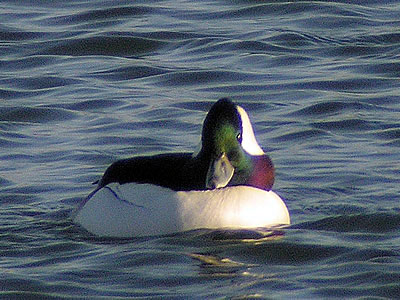
The Bufflehead (Bucephala albeola) is our smallest duck, and the handsome black-and-white males stand out even from a distance. In the right light the head feathers scatter the light and we see flashes of green and violet, as here. Seen yesterday (December 5) on Bodega Bay with Rich Stallcup's group. The bird was not close, and here the severe cropping results in a grainy image. Some day I will get a decent photo of this species, but for now...
2. Black-crowned Night-heron at the spa
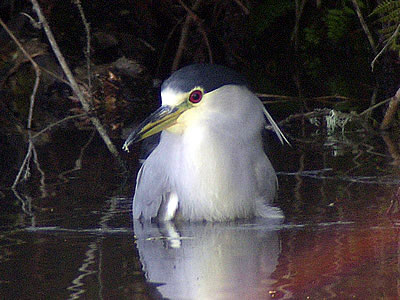
A friend once asked, "Why bird?" The answers of course are complex, varied and personal, but one of the many delights we get from watching our feathered friends is to see them expressing new behaviors (new to us, anyway).
Here is the grumpy Black-crowned Night Heron (Nycticorax nycticorax) sitting chest deep in the water at Hole-in-the-Head pond along Bodega Bay. It was not bathing actively or foraging, but simply sitting there in the shallow water. Soon it began vigorous retching, perhaps trying to expel some indigestible bits, but I'll spare you the undignified photo of that.
Photo notes: taken across a pond, looking into the sun at a bird in deep shade, producing an orange artifact in the right lower corner. Moderate crop, from a larger photo.
3. Western Meadowlark
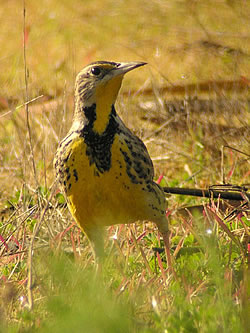
Birders know this species even as they fly quickly past and land in a grassy field. The shape of the head and bill, plus the outer white tails feathers make for an easy ID. Well, at least there is one bird that I can identify as it speeds by. But once they land they tend to turn away and hide their most striking features.
The Western Meadowlark (Sturnella neglecta) is in the Icterid Family, along with the Blackbirds, Cowbirds, and Orioles. Meadowlarks are common, but shy and wary. The photographer has to be quite still and hope that they walk towards the camera, which they usually decline to do. They frequently look up for predators as they forage along the ground, only rarely facing you and exposing their dramatic breasts.
Well, he briefly looked up and faced me. Not great light, but you can appreciate the striking yellow color of the breast and the fancy black chevron. Too bad you can't hear the beautiful song, which they don't volunteer often at this time of year.
4. Loggerhead Shrike
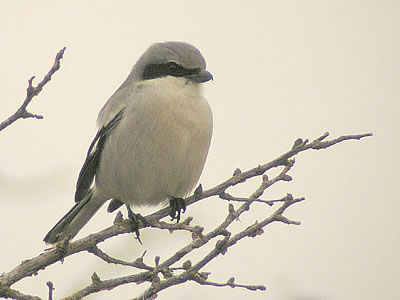
Went birding in the Delta with Don Reinberg on Wednesday. We had nice view of Ferruginous Hawks, a Rough-legged Hawk, Prairie Falcon, and even the Northern Shrike (along Cook Lane, just south of 113, on the west side of the road). But the only bird within photo distance was the Loggerhead Shrike, one of about 4 that we spotted. No, we missed the Mountain Plovers.
The Loggerhead Shrike (Lanius ludovicianus) is one of 30 "true shrikes" in the world, and the only one found exclusively in North America. "Loggerhead" is used in the sense of "blockhead", referring to the large size of the head in relation to the body. Unfortunately the number of Loggerheads has been gradually declining, due to a variety of reasons. See Birds of North America for a full discussion, but factors include habitat loss, weather (decreasing prey in certain years), pesticides, predation (cats, ravens, foxes), and accidents (they forage along roads and are hit by cars). Researchers are uncertain how to best manage the species to halt the decline, but the Loggerhead Shrike is certainly a species of concern in many areas.
These birds are a bit like Kestrels, as they hunt from a perch and are very sharp-eyed, making approach difficult. The dreary cold weather muted the tones nicely.
5. Sandhill Cranes - Grus canadensis
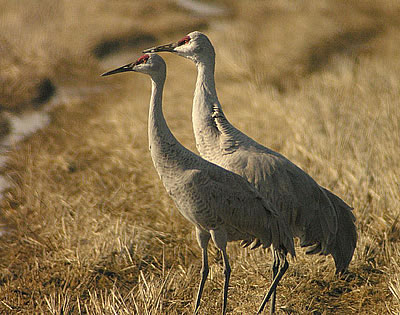
When birding in the Central Valley of California we are sometimes mesmerized by ethereal calls that drift down from great distances. Looking up we can usually spot a group of Sandhill Cranes, which may be quite far away, as their calls carry for miles. The haunting bugling of these magnificent birds is made possible by a trachea that has been elongated and coiled into the sternum, "an anatomic feature that expands the amplitude and alters the pitch by the addition of harmonics." It has been likened to a French Horn. (Bryant - does all that make sense?). But why try to explain the magic. Just go there and listen. We found this group along West Butte Road, and then at Llano Seco we were treated to a flight of over 100 cranes passing by. As Zumie would say, "Wow!"
There are 15 species of Cranes in the world. The Sandhill is the only one we see regularly in the US, as the Whooping Crane is quite rare. The Sandhill has been divided into 6 subspecies, with intergrades said to be common. Most of the Pacific Coast population are supposed to be Lesser Sandhill Cranes (Grus canadensis canadensis). The male is a bit larger than the female, and they may mate for life. In the pair shown here the larger bird has a distinctly bigger head and thicker neck, and looks like it might be 30% heavier. Since the male Sandhill is only supposed to be 10-15% larger, the big bird shown here may be an intergrade with G. c. tabida, the Greater Sandhill Crane. I'm hoping one of you will enlighten us on the subject.
Most Sandhill Cranes nest far to the North, even in Siberia. There are populations that nest in the lower 48, and even 3 resident non-migratory subspecies (Mississippi, Florida, and Cuba). The cranes are in the order Gruiformes, along with the Coots, Rails, Gallinules and Limpkin, but none of them are very closely related to the cranes, which are considered to have evolved as a separate family many millions of years ago.
We always thought the red color of the forehead and lores (one writer described it as "begonia rose") was from pigmented feathers, as in the Woodpecker family. But as you can see in the photo the red area is simply pigmented bare skin. Another interesting feature shown in the photo is the perforation of the internasal septum.
6. White Merganser - Mergellus albellus
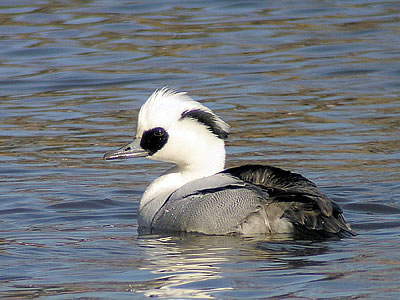
The Latin name Mergellus albellus roughly translates as "small white merganser". Well, White Merganser sounds a lot better than Smew!
The Smew is a rather rare visitor to the U.S., and is not even shown in Sibley's Guide. Check your National Geographic to find this handsome male, the smallest Merganser, and a Eurasian species. Don Reinberg, Rick Baird and I, plus a dozen other birders watched this breath-taking white creature in a small pond along Highway 108, seven miles east of Sonora. Take a right off 108 onto Soulsbyville Rd (traffic light), then first left on Kings. Go to the end and park, then just walk up on the berm. Voila! He seems happy and active, diving frequently and displaying in vain towards the female Hooded Mergansers, who of course won't give him the time of day. Everyone's hoping he will stay for a while.
This shot from the rear belies the fact that he's mostly white
TOWHEE.NET: Harry Fuller, 820 NW 19th Street, McMinnville, OR 97128
website@towhee.net